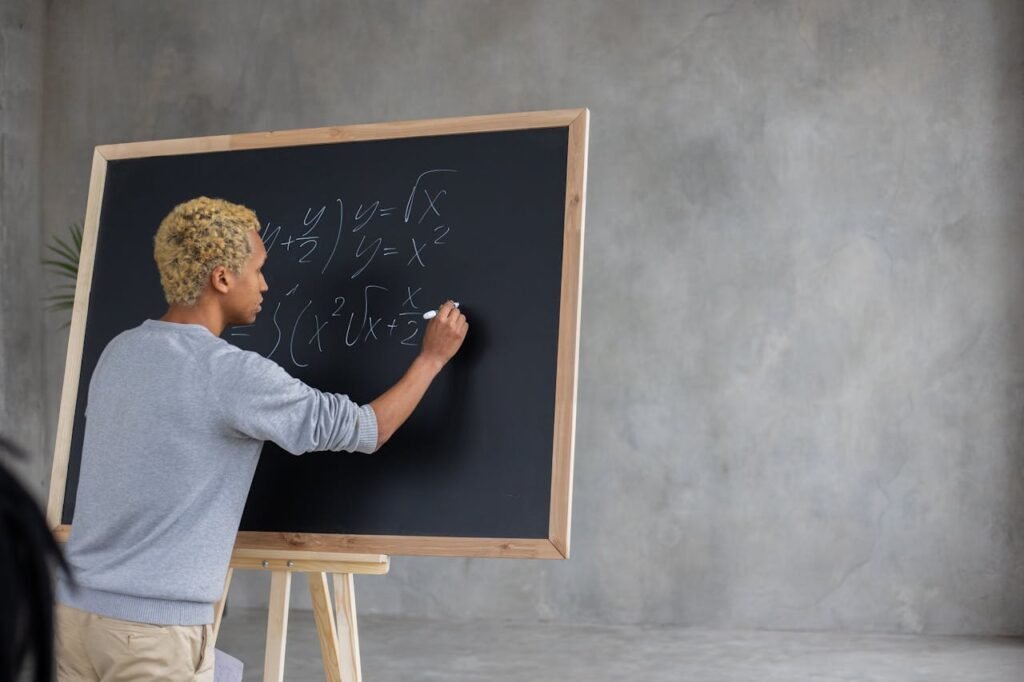For many kids, the moment they see x in a math problem, they freeze. It looks strange. It feels unfamiliar. And suddenly, math seems scary. But here’s the secret: solving for x is just about finding a missing number. That’s it.
The problem is that most students are introduced to linear equations with a bunch of rules and formulas before they truly understand what is happening. At Debsie, we believe it’s better to start simple. We strip away the fear, use everyday examples, and build up step by step—so the “mystery” of x disappears and is replaced with confidence.
In this guide, I’ll walk you through exactly how to explain linear equations in a way that’s clear, relatable, and actually fun. We’ll turn confusing problems into something that makes perfect sense—even for a child who has always said, “I’m not good at math.”
Step 1: Explain What “x” Really Means
Before teaching how to solve for x, we need to make sure kids understand what it is. Most of the time, they’ve seen numbers in math problems—but now there’s a letter. That’s new, and it can feel strange.
I like to start with something they know:
“x is just a box with a secret number inside. Our job is to figure out what’s hiding in the box.”
Sometimes, I’ll even draw a little treasure chest and say, “Inside this chest is a number. We’re going to find it!” This takes away the intimidation and makes x feel like a game.
For example:
x + 3 = 7
Instead of saying “solve for x,” say:
“What number plus 3 equals 7?”
Most kids will quickly say 4. Then I tell them, “Great! That means x = 4.” They’ve just solved their first equation without even realizing it.
Step 2: Use Real-Life Examples First

Before jumping into algebraic steps, connect it to real objects.
Example:
“You have some apples. I give you 3 more. Now you have 7. How many did you start with?”
Kids can imagine the apples. They think: “Hmm… I had 4 apples, then got 3 more, that’s 7.” So the starting apples are x, and they’ve just solved:
x + 3 = 7
The more you connect x to things they can picture—coins, cookies, pencils—the more natural it becomes.
Step 3: Show That Solving for x Means “Balancing”
Now we can introduce the balancing idea, which is key to solving linear equations. I explain it like this:
“Think of the equation as a see-saw. Both sides have to be equal. If you change one side, you must change the other the exact same way.”
Example:
x + 5 = 12
We want to get x alone, so we do the opposite of adding 5—which is subtracting 5—from both sides:
x + 5 - 5 = 12 - 5
x = 7
I actually draw a see-saw with numbers on both sides, and when we “take away” the same thing from each side, the see-saw stays balanced.
This step works really well if you have physical objects—like a small balance scale or even two bowls and some marbles—to show what it means to keep both sides the same.
Step 4: Break Down Multi-Step Equations Slowly
Once a student is comfortable with simple one-step equations, we can introduce ones that require two moves. I always tell them:
“We still want to get x alone. We just have to do it step by step.”
Example:
2x + 3 = 11
I’ll ask: “What’s the first thing we should undo?” The idea is to reverse the order of operations. Since 3 was added last, we remove it first:
2x + 3 - 3 = 11 - 3
2x = 8
Then we undo the multiplication by 2 (which is division):
2x ÷ 2 = 8 ÷ 2
x = 4
I make sure they see we’re doing the same thing to both sides each time—just like with the see-saw balance idea.
Step 5: Keep It Visual and Physical
Some kids need to “see” what’s happening. I like to use tokens or counters for this:
For 2x + 3 = 11, I put two cups (these are the x’s) and 3 marbles on one side, and 11 marbles on the other.
- First, remove 3 marbles from both sides → now it’s just 2 cups = 8 marbles.
- Then split the marbles equally between the two cups → 4 marbles in each cup → x = 4.
This physical act of removing and dividing makes the process stick in their memory.
Step 6: Use Stories for Trickier Problems
Kids remember better when there’s a story. I’ll turn 3x - 4 = 8 into:
“You have 3 equal baskets of apples. Then you give away 4 apples. Now you have 8 apples left. How many apples in each basket?”
They add the 4 back first (undoing subtraction), then divide the total by 3. It’s the same equation, but a lot less scary when told as a real-life puzzle.
Step 7: Practice Without Making It Feel Like Drill

Instead of handing over a boring worksheet, I’ll mix problems into fun activities:
- Equation treasure hunt – Hide cards around the room, each with an equation. Kids solve them to get the next “clue.”
- Equation bingo – Each bingo square has an equation; solving it tells them which spot to mark.
- Mystery number challenge – I pretend to think of a number, then give clues in equation form: “My number times 2 plus 5 is 13—what’s my number?”
By keeping the energy playful, kids end up solving far more equations than they realize.
Step 8: Spotting and Fixing Common Mistakes
Even when kids understand the steps, there are a few mistakes that pop up often. The good news? Once you know what they are, you can prevent them with a little extra guidance.
Mistake 1: Forgetting to Do the Same Thing on Both Sides
Example:
x + 4 = 9
Some kids subtract 4 from the left but forget to subtract 4 from the right. This breaks the “see-saw balance” rule.
How to fix it:
I remind them:
“The two sides are twins. Whatever you do to one twin, you must do to the other.”
I’ll actually write the operation on both sides of the equation in the same color so they can see the symmetry:
x + 4 - 4 = 9 - 4
x = 5
Mistake 2: Doing Steps in the Wrong Order
Example:
2x + 5 = 11
Some kids divide by 2 first instead of removing the +5, which can lead to confusion or wrong answers.
How to fix it:
Teach them to “peel away” the equation like layers of clothing. You remove the last thing that happened to x, first. In 2x + 5 = 11, the last thing that happened was +5, so we undo that first.
Mistake 3: Forgetting Negative Signs
Example:
x - 7 = -3
Kids sometimes see -3 and forget it’s a negative number, or they accidentally turn it positive.
How to fix it:
I tell them:
“The sign in front of the number is like its name tag—it’s part of who it is. Never leave it behind.”
We circle the negative sign with the number so it’s clear that they belong together.
Mistake 4: Rushing Without Checking
Some kids get the answer but never check it. This can lead to small errors going unnoticed.
How to fix it:
I train them to always put their answer back into the original equation:
Example:
If x = 4 in 2x + 3 = 11, check:2(4) + 3 = 8 + 3 = 11 ✅ correct.
Checking feels like a small step, but it builds confidence and accuracy.
Step 9: Building Confidence Along the Way
One of the biggest mistakes isn’t about numbers—it’s about mindset. Some kids get one wrong answer and immediately think, I’m bad at math.
At Debsie, we make sure students see mistakes as clues, not failures. If something doesn’t work, it just means we have to try another path. This shift in thinking is often the difference between a child who gives up and a child who grows.
Step 10: Making Fractions Friendly in Equations

Fractions are where many students start to panic, so we have to soften the fear right away. I usually start with this reminder:
“A fraction is just a number in disguise.”
Instead of introducing fractions inside equations too soon, I first review what the fraction means and how to clear it.
Example:
x/2 = 6
I’ll say: “x is being divided by 2. What’s the opposite of dividing by 2?”
They’ll answer: “Multiply by 2.”
So we multiply both sides:
(x/2) × 2 = 6 × 2
x = 12
Fractions With More Steps
Example:
(2x)/3 + 4 = 10
Step-by-step:
- Remove the +4 first:
(2x)/3 = 6
- Multiply both sides by 3:
2x = 18
- Divide by 2:
x = 9
By breaking it into small, obvious moves, fractions stop feeling scary.
Step 11: Variables on Both Sides
Once students are confident with single-variable equations, we can introduce ones where x appears on both sides.
Example:
2x + 3 = x + 7
I tell them:
“If you have x’s on both sides, get all the x’s together on one side and all the numbers on the other.”
Step-by-step:
- Subtract x from both sides:
x + 3 = 7
- Subtract 3 from both sides:
x = 4
A Trick to Keep It Clear
I use “Team x” and “Team numbers.” All the x’s go to one team, all the numbers go to the other.
This makes it visual: “Let’s get all the players on the same side.”
Step 12: Word Problems That Use These Skills
The real magic happens when students use these skills in real-life problems.
Example:
“You and your friend are saving money. You already have $3, and save $2 every week. Your friend has $9 but doesn’t save anything. After how many weeks will you have the same amount?”
Equation:
2x + 3 = 9
Solve:
- Subtract 3 from both sides:
2x = 6 - Divide by 2:
x = 3 weeks
When students see that equations answer real questions, their motivation shoots up.
Step 13: Fun Games That Teach Solving for x
The fastest way to make linear equations stick is to wrap them inside activities kids want to do. Here are some I’ve used that work wonders:
Equation Relay
Write different equations on slips of paper and place them around the room. Kids work in pairs or teams, solving one equation to “unlock” the location of the next. This adds movement and excitement to what’s usually a desk activity.
Mystery Box Math
Use actual boxes with objects inside. The number of objects is the “x.” Give clues in equation form:
“The number in the box plus 7 equals 15. What’s in the box?”
They solve, then check by counting the real objects.
Escape Room Challenge
Set up a math “escape room” where each correct equation answer gives them part of a code. They have to solve all to “unlock” the final prize.
Step 14: Teaching Hacks for Solving x With Confidence

Through years of teaching, I’ve found a few tricks that change the game for struggling students:
1. Color Code Every Step
Use one color for x-terms, another for constants. This makes it easier for students to visually separate the “number friends” from the “x friends.”
2. Say Every Step Out Loud
Encourage them to speak what they’re doing:
“I’m subtracting 5 from both sides.”
It slows them down and reinforces the logic.
3. Always Check the Answer
Turn checking into a “victory lap.” It’s the final proof they cracked the code. This builds pride and accuracy.
Step 15: How Debsie Teaches Solving for x Without Confusion
At Debsie, our approach is different. We don’t drop kids into a pool of abstract formulas and hope they swim. We guide them gently, step by step, using stories, visuals, and hands-on tools.
Here’s how we do it:
- Live, patient teachers who answer every “why?” and “how?” in real time.
- Everyday examples—from snacks to savings—to make equations relatable.
- Interactive tools that let kids move numbers around on screen or on paper.
- Confidence-building games so they learn without fear of mistakes.
Our goal isn’t just to have a child solve for x. It’s to have them understand why they’re doing it—and feel good about it.
Step 16: Real-Life Uses of Solving for x
When kids ask, “When will I ever use this?” the answer is—more often than they think. Linear equations pop up in everyday situations, even if they’re not written out as math problems.
Here are a few ways they show up:
- Budgeting and saving – Figuring out how many weeks it will take to save a certain amount.
- Cooking – Adjusting recipes: “If 3 cups of flour make 12 cookies, how much flour makes 20 cookies?”
- Travel planning – Working out how long it will take to get somewhere based on speed and distance.
- Shopping – Calculating discounts or deciding how many items can be bought with a set budget.
- Sports – Tracking averages: “If I need my batting average to be .300, how many more hits do I need in my next games?”
The truth is, solving for x is just learning how to work backward to find an unknown—and that’s a problem-solving skill that stays useful for life.
Step 17: How the Skill Grows With Age
When kids start, x might just be a number in a one-step problem. But as they grow, the same concept expands into:
- Harder equations with fractions, decimals, and negatives.
- Systems of equations to solve more than one unknown.
- Real-world modeling for science, engineering, and finance.
The beauty is that once a child understands the logic of balancing and isolating x, the complexity can increase without overwhelming them—because the foundation is already solid.
The Debsie Difference

At Debsie, we believe that math success isn’t about speed—it’s about understanding. Many children are capable of solving for x, but the way it’s traditionally taught often leaves them confused, anxious, or convinced they’re “just not good at math.” We exist to change that story.
We’ve helped students from over nine countries and across every age group—from early learners who have never seen an equation before to teens preparing for advanced exams. No matter where a child starts, our goal is the same: build confidence first, mastery second. When a child feels safe to explore, make mistakes, and ask questions, they begin to see math as something they can do—and even enjoy.
Here’s what makes Debsie’s approach different from other learning platforms:
🧑🏫 Real Teachers, Real Connection
Every Debsie class is taught live by an experienced educator who understands how kids think. Our partner teachers are not only experts in math—they’re mentors who listen, encourage, and adapt.
They notice when a student hesitates, step in with patient explanations, and find new ways to explain a concept until it clicks. This live, personal interaction means your child is never left staring at a confusing problem alone—they’re guided through it with kindness and clarity.
✋ Learning by Seeing, Doing, and Talking
We know that children learn best when they can see what’s happening, try it themselves, and explain it back. That’s why our lessons combine:
- Visual tools – We use animations, drawings, and balance-scale demonstrations so kids see why each step in solving for x works.
- Hands-on methods – Students might build equations using blocks, coins, or cards so they can physically “balance” both sides.
- Verbal reasoning – We encourage students to talk through their thinking, which deepens understanding and makes problem-solving more natural.
This triple approach—visual, physical, verbal—ensures the concept doesn’t just stay in their short-term memory. It sticks.
🎯 Personalized Learning Paths for Every Child
Some students need to slow down and master one-step equations before moving forward. Others are ready to tackle fractions and variables on both sides right away. At Debsie, we adjust the pace, examples, and challenges for each individual student.
We also pay attention to learning styles. A creative child might get more story-based problems. A logical thinker might thrive on puzzle challenges. The learning path fits your child—not the other way around.
🎮 Motivation Through Gamified Learning
Kids love progress they can see and celebrate. That’s why Debsie uses gamified learning—earning points, unlocking levels, and completing “math missions.”
Instead of “do ten problems for homework,” we might say:
“Complete this challenge to earn enough points to unlock the next clue!”
Suddenly, practice feels like a game. Kids solve more problems without realizing they’re doing extra work—because they’re having fun.
💬 Partnering With Parents
We believe parents should be part of the journey, without having to become the math teacher at home. That’s why we send:
- Clear progress updates – So you know exactly what your child is learning and achieving.
- Guidance on next steps – So you can support your child without stress.
- Celebration notes – Because every breakthrough is worth sharing.
Parents often tell us, “I finally understand what my child is doing in math, and they’re excited to show me!”
🌍 A Safe, Global Community of Learners
When your child joins Debsie, they join a worldwide family of curious kids. They get to see other students solving the same problems, cheering each other on, and learning together.
It’s motivating for a child to realize: “I’m part of something bigger. I’m not alone in this.” And because we ensure a safe, moderated space, parents can trust that their children are learning in a positive environment.
💡 More Than Just Solving for x
When a student learns to solve for x with us, they’re learning far more than algebra. They’re developing:
- Logical thinking – Step-by-step reasoning they can apply anywhere.
- Patience – Understanding that problems take time to solve.
- Resilience – Confidence to try again when something doesn’t work the first time.
These are life skills that go beyond math class. They shape how children approach challenges in school, work, and life.
Final Thoughts: Turning “I Can’t” Into “I Can”
Solving for x isn’t just about equations—it’s about problem-solving. It’s about facing something unfamiliar, breaking it down, and finding the answer step by step. When kids learn this, they’re not just doing math. They’re training their brains to tackle challenges in any area of life.
At Debsie, we’ve seen the transformation hundreds of times—a hesitant student becomes a confident one, the “I’m not good at math” turns into “This is actually kind of fun.”
🎓 Ready to see that change in your child?
🎉 Book a free trial class at Debsie today and let us help them solve for x—and for confidence, clarity, and a lifelong love of learning.
Read next:
